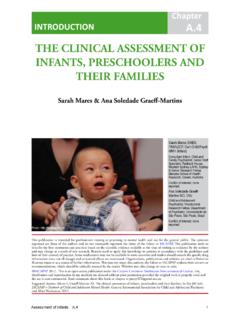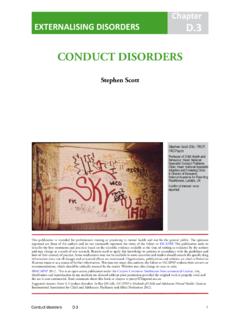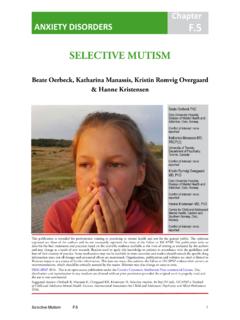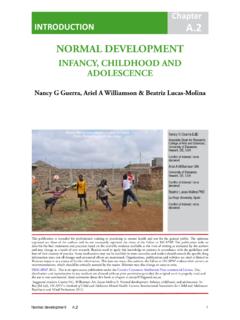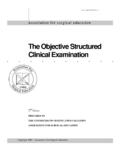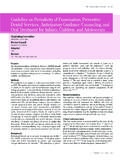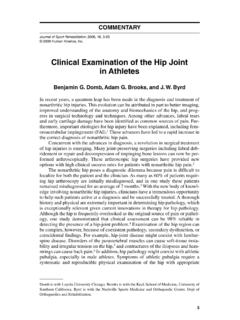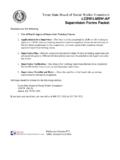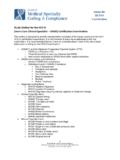Transcription of THE CLINICAL EXAMINATION OF CHILDREN ... - iacapap.org
1 CLINICAL EXAMINATION Textbook of Child and Adolescent Mental Lempp, Daleen de Lange, Daniel Radeloff & Christian BachmannTHE CLINICAL EXAMINATION OF CHILDREN ,ADOLESCENTS AND THEIR FAMILIESThis publication is intended for professionals training or practicing in mental health and not for the general public. The opinions expressed are those of the authors and do not necessarily represent the views of the Editor or IACAPAP. This publication seeks to describe the best treatments and practices based on the scientific evidence available at the time of writing as evaluated by the authors and may change as a result of new research.
2 Readers need to apply this knowledge to patients in accordance with the guidelines and laws of their country of practice. Some medications may not be available in some countries and readers should consult the specific drug information since not all dosages and unwanted effects are mentioned. Organizations, publications and websites are cited or linked to illustrate issues or as a source of further information. This does not mean that authors, the Editor or IACAPAP endorse their content or recommendations, which should be critically assessed by the reader.
3 Websites may also change or cease to exist. IACAPAP 2012. This is an open-access publication under the Creative Commons Attribution Non-commercial License. Use, distribution and reproduction in any medium are allowed without prior permission provided the original work is properly cited and the use is non-commercial. Send comments about this book or chapter to Suggested citation: Lempp T, de Lange D, Radeloff D, Bachmann C. The CLINICAL EXAMINATION of CHILDREN , adolescents and their families. In Rey JM (ed), IACAPAP e-Textbook of Child and Adolescent Mental Health.
4 Geneva: International Association for Child and Adolescent Psychiatry and Allied Professions Lempp MDDepartment of Child and Adolescent Psychiatry, Goethe-University of Frankfurt, GermanyConflict of interest: none reportedDaleen de Lange MDOkonguarri Psychotherapeutic Centre, NamibiaConflict of interest: none reportedDaniel Radeloff MDDepartment of Child and Adolescent Psychiatry, Goethe-University of Frankfurt, GermanyConflict of interest: none reportedChristian Bachmann MDDepartment of Child and Adolescent Psychiatry, Charit - Universit tsmedizin Berlin, GermanySherlock Holmes statue at Meiringen, Switzerland (Wikipedia commons)2 CLINICAL EXAMINATION Textbook of Child and Adolescent Mental HealthConflict of interest: none reportedAcknowledgements: our gratitude to Friderike Fornoff (University of Frankfurt) and Joseph Rey (University of Sydney) for their help in preparing this chapter.
5 Would you like to share your CLINICAL pearls ?If you have comments regarding this chapter, especially more CLINICAL pearls from your own work you are cordially invited to send us your suggestions to Sherlock Holmes illustrations are from Sidney Paget (1860-1908), who illustrated Conan Doyle s stories in The Strand OF READING THIS CHAPTER You are a beginner in the field of pediatric mental health:Welcome to this exciting subspecialty! We are inviting you to sit back and read the whole chapter. You are already experienced and trying to improve your EXAMINATION skills:We suggest that you read the CLINICAL pearls in the right column and try them out in your practice.
6 If you wish, you may collect more of them and share them with clinicians all over the world by sending them to the authors for the next edition of this chapter. You are experiencing difficulties with a specific patient s diagnostic assessment:We suggest that you read the troubleshooting box at the end of this chapter (pages 23-24). If this does not help, check our reading recommendations in the references section (pages 24-25).Why should I read this chapter?In many respects it seems worthwhile giving special attention to the CLINICAL EXAMINATION process in child psychiatry (except when otherwise specified, child refers to child and adolescent ): It is obvious that there has to be a thorough and comprehensive diagnostic evaluation before treatment can be considered.
7 If the diagnosis is wrong, incomplete, not understood or accepted by all parties involved, the chances of treatment failing are fairly high. The planning and initiation of a treatment regime in child and adolescent psychiatry is usually time-consuming and costly. Therefore, the time spent in the diagnostic process to create a valid and solid foundation for effective treatment planning is wisely invested. There are distinctive developmental aspects in the mental health EXAMINATION of CHILDREN and adolescents, which deserve special attention.
8 CHILDREN and adolescents are not little adults. They cannot be assessed in isolation, speak a different language to the clinician and rarely seek help by themselves. Especially for beginners in the field, it is easy to get confused by the amount of information and by inconsistent reports. To minimize this, it is helpful to be clear about the aims of the evaluation process. The art in daily practice is in finding the balance between standardization and individualization when using different methods to reach these aims.
9 Distinctive aspects of the mental health EXAMINATION in CHILDREN and adolescents CHILDREN rarely initiate psychiatric assessment and the referral is typically requested by someone other than the patient ( , parents, teachers, pediatricians, courts). This can be of paramount importance in the interpretation of the case. Perhaps the adult s expectations for the child exceed the child s abilities, or the parenting style may result in a poor fit between parents and this particular child, and parents seek to I like to think of myself as Sherlock Holmes during this time.
10 I use the more obvious clues (usually the presenting complaint) to begin the investigation, as well as digging deeper to understand the nature of the symptoms and behavior, and the biological, psychological and social factors, which are precipitating and maintaining the impairing symptoms. (Stubbe, 2007). Whatever the age of the child, and whatever the CLINICAL issue, it is important that the interview combines an appropriate degree of structure and standardization (which are essential for comparability across CHILDREN ) and sensitivity to the unexpected and to the individual issue.
